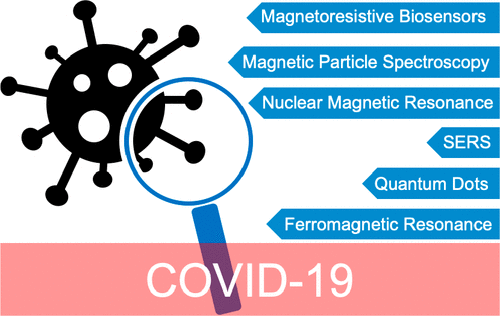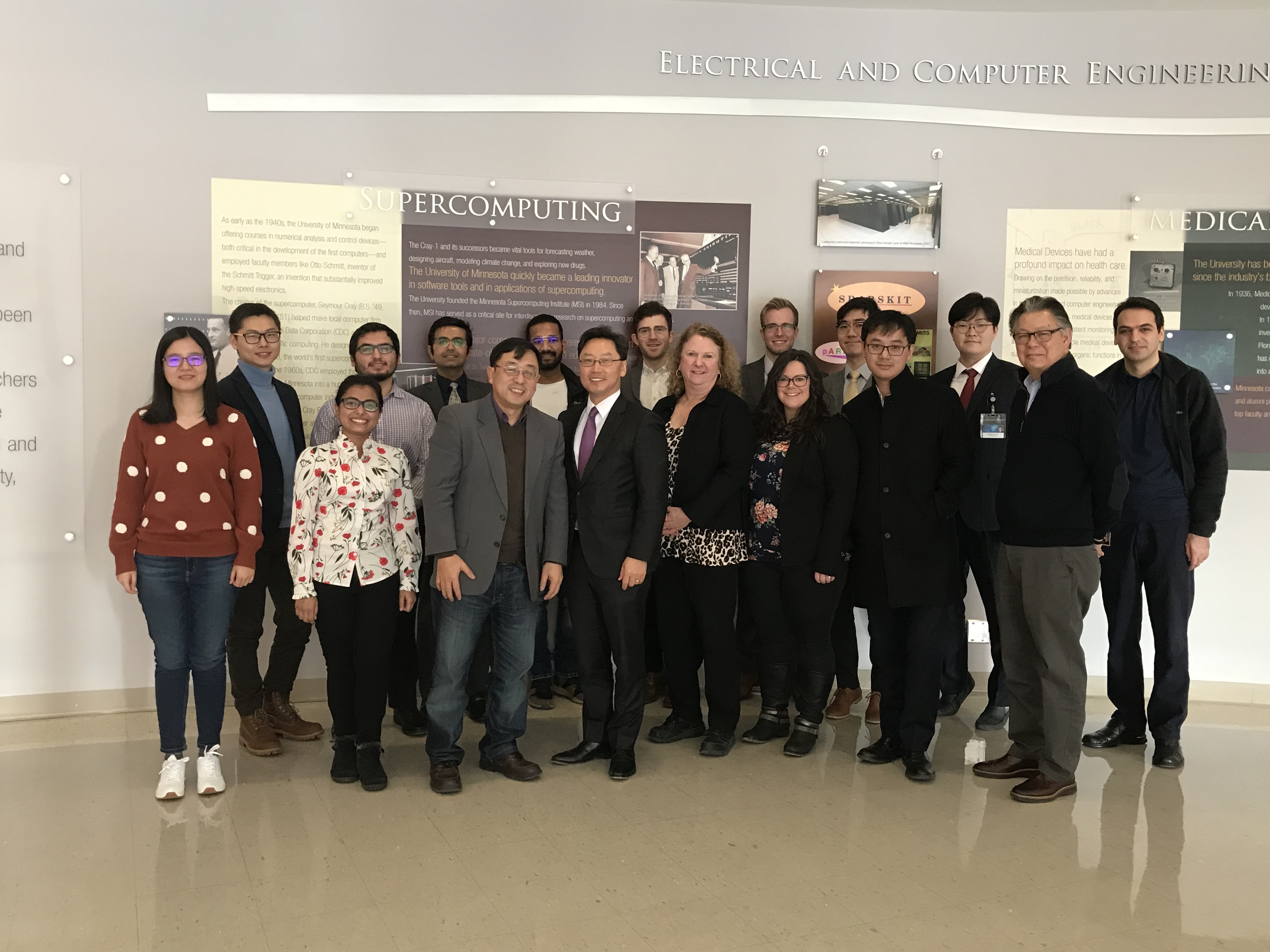
Magnetic-Nanosensor-Based Virus and Pathogen Detection Strategies before and during COVID-19
Dr. Kai Wu and coauthors have recenlty pubsliehd a review paper on ACS Appl. Nano Mater. titled "Magnetic-Nanosensor-Based Virus and Pathogen Detection Strategies before and during COVID-19". They reviewed the popular magnetic nanosensing techniques including magnetoresistance, magnetic particle spectroscopy, and nuclear magnetic resonance. Magnetic point-of-care diagnostic kits are also reviewed aiming at developing plug-and-play diagnostics to manage the SARS-CoV-2 outbreak as well as preventing future epidemics. In addition, other platforms that use magnetic nanomaterials as auxiliary tools for enhanced pathogen and virus detection are also covered. The goal of this review is to inform the researchers of diagnostic and surveillance platforms for SARS-CoV-2 and their performances.

This review article is open access.
Prof. Jian-Ping Wang Elected Fellow of American Physical Society
Distinguished McKnight University Professor Jian-Ping Wang has been elected fellow of the American Physical Society (APS). The APS citation reads: “For outstanding contributions to the synthesis and fundamental understanding of magnetic and spintronic materials, and to the fabrication of devices for applications in computing.”
News source: UMN ECE
Graduation of Dr. Liu!
Congratulations to Dr. Jinming Liu. He has successfully defended his PhD thesis titled "Synthesis of Magnetic Materials for Rare-Earth-Free Permanent Magnets Applications"!
Dr. Liu first experimentally reported body-centered tetragonal (bct) Fe nanoparticles. He first reported α”-Fe16N2 foils synthesized by a low-temperature nitriding process. He has authored and co-authored over 20 journal papers including Acta Materialia, Physical Review Materials, Small, and ACS Applied Materials & Interface, etc
Renata and coworkers' work highlighted on JPDApplied cover
Congratulations to Renata and coauthors, their joint work "Tunable magnetic skyrmions in spintronic nanostructures for cellular-level magnetic neurostimulation" is highlighted on the cover of Journal of Physics D: Applied Physics.
Magnetic Particle Spectroscopy for the Detection of Influenza A Virus Subtype H1N1
Congratulations to Dr. Kai Wu and the co-authors. Their join work "Magnetic Particle Spectroscopy for Detection of Influenza A Virus Subtype H1N1" is publisehd in ACS Appl. Mater. Interfaces.
In this work, they introduced a new biosensing scheme based on magnetic particle spectroscopy (MPS) and the self-assembly of MNPs to quantitatively detect H1N1 nucleoprotein molecules. The H1N1 nucleoprotein molecule hosts multiple different epitopes that forms binding sites for many IgG polyclonal antibodies. Anchoring IgG polyclonal antibodies onto MNPs triggers the cross-linking between MNPs and H1N1 nucleoprotein molecules, thereby forming MNP self-assemblies. Using MPS and the self-assembly of MNPs, we were able to detect as low as 44 nM (4.4 pmole) H1N1 nucleoprotein.
Review paper “High-moment magnetic nanoparticles” published online
Congratluations to Jinming and coauthors, their review paper titled "High-moment magnetic nanoparticles" is publisehd on the Journal of Nanoparticle Research.
High-moment magnetic nanoparticles (MNPs) such as FeCo are attracting intense interest for biomedical applications. In this review, the applications of these high-moment MNPs such as magnetic hyperthermia, drug delivery, magnetic resonance imaging (MRI), and biosensing are summarized. We believe that the high-moment MNPs are promising candidates for many bio-applications.
Researchers from the University of Minnesota and Mayo Clinic to develop magnetic nanodevice arrays to treat neurological diseases
A project jointly undertaken by scientists from ECE, the departments of Neurosurgery, and Biomedical Engineering, and the Mayo Clinic has received close to $1 million in a grant from the Minnesota Partnership for Biotechnology and Medical Genomics. The project is titled, “Magnetic Nanodevice Arrays for the Treatment of Neurological Diseases.” The funding will enable the team to develop an implantable magnetic nanodevice array with the ability to generate highly localized magnetic fields for neuromodulation.
The project will be led by Distinguished McKnight University Professor and Robert F. Hartmann Chair in Electrical Engineering, Jian-Ping Wang (ECE), and Prof. Kendall H. Lee of the Mayo Clinic. Other investigators on the team are Prof. Tay Netoff (Dept. of Biomedical Engineering), and Prof. Walter C. Low (Dept. of Neurosurgery). The grant is spread over 2 years, effective February 2020.
Dr. Wu is featured on ECE website
Our current group member, postdoctoral associate, Dr. Kai Wu, is recently featured on the Department of Electrical and Computer Engineering website. Dr. Wu graduated from our group with a PhD degree in 2017. He is the first student in our group to get the PhD degree within four years right after his undergraduate study. Since joininng our group in 2013, Dr. Wu has published over 30 papers in journals including Small, ACS Applied Materials & Interfaces, and ACS Sensors. He has also authored a book chapter titled “Magnetic Nanoparticle-based Biosensing” in Clinical Applications of Magnetic Nanoparticles: From Fabrication to Clinical Applications (edited by N.T. Thanh).
Check out the featured story: Crossing Disciplinary Borders with Dr. Kai Wu: Engineering in Medicine
Check out Dr. Wu's work from his personal page
Dr. Lee's team from Mayo Clinic visiting our lab
Dr. Lee’s team from Mayo Clinic is visiting our lab on this Friday (Jan 10th). His team is working on the deep brain stimulation treatments. Profs. Tay Netoff, Walter C. Low, and Zhi Yang also joined today's meeting. The PIs, postdocs, researchers, and PhD students discussed the ongoing research and future collaboration plans.

Diqing's article is featured on the cover of Journal of Applied Physics
Congratulations to Diqing and coauthors, their recent article “Tunable magnetic domain walls for therapeutic neuromodulation at cellular level: Stimulating neurons through magnetic domain walls,” has been featured on the cover of Journal of Applied Physics.